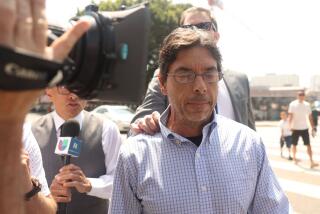Doctor arrested in probe of painkiller overdoses
- Share via
Reporting from Santa Barbara -- A Santa Barbara doctor linked by authorities to a dozen drug-related deaths in recent years has been arrested by DEA agents on federal drug trafficking charges.
The arrest of Dr. Julio Diaz comes amid a nationwide surge in prescription drug overdose deaths drawing newfound attention from law enforcement and public health officials.
Diaz, 63, has been under investigation for years for allegedly prescribing addictive painkillers and other commonly abused drugs to patients who had no legitimate need for the medications.
The doctor has not been charged in connection with the deaths, which remain under investigation, but some are detailed in a 75-page arrest affidavit unsealed Wednesday afternoon after he was taken into custody. The deceased patients ranged in age from 26 to 58. Eleven overdosed and one died of natural causes with drug abuse listed as a contributing factor.
The affidavit depicts Diaz as a drug-dealing doctor known to some patients as “the candy man ... because they knew he was the man to go to for drugs.” Two female patients treated at a local emergency room told hospital staff that they and their friends got drugs from Diaz in exchange for sexual favors. Doctors at a local hospital considered Diaz such a menace that they kept a spreadsheet documenting his patients’ emergency room visits.
Agents and local police arrested Diaz at his home in Goleta at dawn. They later escorted him to his office on Milpas Street in Santa Barbara, where they seized files, computers and other evidence.
“They believe I was giving too much medication,” a subdued Diaz told a reporter as he was led from his office in handcuffs.
The affidavit details the deaths of 12 patients. A Times review of coroners’ reports identified several additional cases in which patients were treated by Diaz or received prescriptions from him and later died of overdoses.
In an interview with The Times in October, Diaz initially said he was aware of only one fatal overdose within his practice. After being questioned by reporters about individual cases, he acknowledged multiple deaths and said he shared blame in some of them.
“I do feel responsible,” Diaz said in the interview, conducted in an examination room in his two-story office, which is wedged between a sports bar and a discount store. “I was the one providing the medications and perhaps there were some hints there that I should have known they were going to overdose.”
Looking back, he said, the overdoses “gave me a good lesson.”
Among those who died: A 49-year-old father who overdosed on painkillers after recently completing a 60-day drug rehab; a 35-year-old mother found dead in her bedroom by her young daughter, who was hosting a friend for a sleepover; an out-of-work county bus driver who overdosed on painkillers and other drugs as she grew increasingly depressed over the upcoming anniversary of her 20-year-old son’s overdose death, which she attributed to her son taking painkillers that Diaz had prescribed to her.
The woman’s husband, Amos Barajas, was one of several deceased patients’ loved ones who raised concerns about Diaz’s alleged overprescribing.
“Amos was angry about the amount of medications being prescribed,” according to a coroner’s report on the woman’s December 2009 death. “Amos felt Dr. Diaz was going ‘overboard.’”
The arrest affidavit described a father holding an all-night vigil in the emergency room where his 20-year-old son had been brought for a drug overdose. He later learned that Diaz had been prescribing “huge quantities” of drugs to his son, who told investigators that he learned of Diaz from a fellow inmate in county jail. Three other parents made complaints to the Medical Board of California regarding Diaz’s treatment of their children, the affidavit states.
Three Santa Barbara doctors and a registered nurse signed a letter they sent to the medical board in 2009, saying that they had treated several patients addicted to large doses of narcotics prescribed by Diaz and that at least one Diaz patient per month was admitted to the hospital for detox.
In the interview with The Times, Diaz described himself as a caring family physician who gradually developed a pain practice to meet the needs of patients who had difficulty finding help elsewhere. That part of his practice, he said, was fraught with trouble, such as drug-seeking patients, office burglaries, pharmacists refusing to fill his prescriptions, complaints from patients’ loved ones and the specter of investigation.
Diaz said that even in some cases in which he suspected a patient was abusing drugs he would continue prescribing so that he could manage what they were taking.
“If you don’t give them the medications they are going to go to the street,” he said. “That has become an issue of: What is the worse of two evils?”
Diaz said he became far more restrictive in treating pain patients after a string of deaths in 2009. At that point, he said, he began checking all his pain patients in a state database that shows whether they are receiving controlled substances from other doctors. He said he also became more aggressive in conducting drug screenings to detect the presence of illegal narcotics and to show whether his patients were actually taking the medications he prescribed as opposed to selling them. Over the years, Diaz said, he has kicked out eight of every 10 pain patients from his practice for violating the rules.
Dr. Chris Lambert, who until recently was senior partner of the emergency medical group at Santa Barbara’s Cottage Hospital, said he and colleagues watched in frustration for years as one Diaz patient after another turned up in his emergency room.
“How many deceased patients and bereaved relatives will it take before somebody says no more?” Lambert asked in an interview with The Times. “There is an underserved population that Dr. Diaz was serving. But, unfortunately, his prescribing practices far outweighed the benefit.”
Diaz said he was aware of how he was viewed by other doctors in town. But he said many of his pain patients were introduced to narcotics by emergency room physicians and had been prescribed drugs for years before arriving at his office.
“Oh, all these cases we see are Dr. Diaz cases,” Diaz said, quoting his detractors. “I go, ‘Who started the medication?’”
“They don’t like to listen to me, but it’s true,” he added.
Patient reactions to the closure of Diaz’s office reflected the diversity of his patient base.
Berta Perez, 93, was visibly distraught. She crossed Milpas, leaned her head against a street lamp and sobbed. She said she had seen Diaz for years and he had treated her for everything from mosquito bites to cancer.
“The doctor is a very good person,” she said. “I trusted him.”
Perez said Diaz saw a lot of poor and older patients.
“He saved me from cancer,” she added. “I am very grateful to him.”
Hours later, another woman, appearing unkempt and agitated, stood, stared at the “office closed” sign and yelled in anger.
Diaz is expected to appear in court Thursday.
More to Read
Sign up for Essential California
The most important California stories and recommendations in your inbox every morning.
You may occasionally receive promotional content from the Los Angeles Times.













